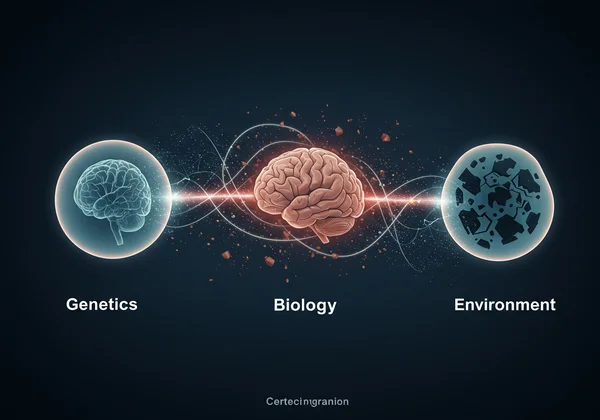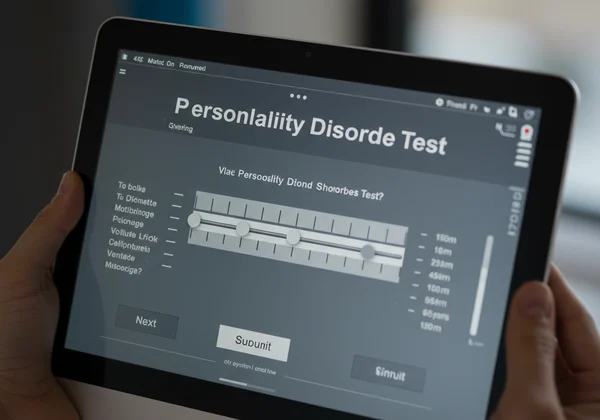Understanding Borderline Personality Disorder: Symptoms, Causes, and How to Take a Personality Disorder Test
Navigating the complexities of Borderline Personality Disorder (BPD) can feel overwhelming, both for those who experience its traits and their loved ones. You might be asking yourself, "How do I check if I have a personality disorder?" or simply trying to understand intense emotions and unstable relationships. If you're grappling with intense emotions or unstable relationships, understanding Borderline Personality Disorder (BPD) can be a crucial first step. As someone passionate about psychology, I aim to clarify this often-misunderstood condition, exploring its symptoms, potential causes, and avenues for effective support. First and foremost, truly understanding BPD is vital for managing its challenges and moving towards healing. For a confidential and insightful starting point, you can always explore a preliminary screening by taking a free test on the Personality Disorder Test homepage.
Understanding Borderline Personality Disorder Symptoms
Borderline Personality Disorder symptoms are a complex array of emotional, behavioral, and relational patterns. They often lead to significant distress and impairment in daily life. While only a mental health professional can provide a diagnosis, recognizing these patterns can be the first step toward seeking help.
Emotional Dysregulation & Instability
Emotional dysregulation is central to BPD, meaning emotions hit very intensely and it's tough to return to a calm state. This means experiencing emotions very intensely and having difficulty returning to a baseline. Minor triggers can lead to dramatic shifts in mood, from extreme sadness to intense anger or anxiety, often within a short period. These rapid and unpredictable emotional changes can make daily life feel like a constant rollercoaster, impacting an individual's sense of stability and well-being.

Impulsive Behaviors & Risk-Taking
Individuals with BPD often struggle with impulsive behaviors and a tendency towards risk-taking. This might manifest in areas such as spending sprees, reckless driving, substance abuse, binge eating, unsafe sexual practices, or self-harm. These actions often provide a fleeting escape from overwhelming emotional pain or a way to feel anything when numbness sets in. But while the relief might be temporary, the long-term consequences are often negative.
Intense Relationships & Fear of Abandonment
Relationships for individuals with BPD are often characterized by intensity, instability, and a pervasive fear of abandonment. They may idealize others rapidly, forming intense attachments, only to devalue them just as quickly when perceiving a slight or rejection. This "splitting" phenomenon can lead to a cycle of tumultuous relationships, marked by frequent arguments, breakups, and reconciliations. The deep-seated fear of being left alone often fuels desperate attempts to prevent perceived abandonment.
Distorted Self-Image & Identity Disturbances
A significant struggle for those with BPD is a pervasive distorted self-image and profound identity disturbances. There can be a fluctuating sense of self, values, goals, and even sexual identity. One day, a person might feel confident and purposeful, while the next, they feel completely lost, empty, or even evil. This instability in self-perception contributes to feelings of chronic emptiness and a lack of a cohesive sense of who they are.
Exploring the Causes of Borderline Personality Disorder
Understanding the BPD causes is crucial, as BPD is not typically attributed to a single factor but rather a complex interplay of various influences. Research suggests a combination of genetic, biological, and environmental factors contributes to its development.

Genetic and Biological Factors
Evidence points to a genetic predisposition for BPD. Studies show that people with close relatives who have BPD are more likely to develop the disorder themselves, suggesting that genetic factors play a role. Additionally, brain imaging studies have revealed certain structural and functional differences in areas of the brain that regulate emotions, impulsivity, and decision-making in individuals with BPD. These biological components may affect how a person processes emotions and responds to stress.
Environmental & Childhood Experiences
Traumatic environmental and childhood experiences are frequently associated with the development of BPD. This can include experiences of abuse (physical, sexual, or emotional), neglect, chronic invalidation of emotions, or significant family disruption during childhood. While not everyone who experiences trauma will develop BPD, these experiences can profoundly impact emotional development and coping mechanisms, potentially leading to the behavioral and emotional patterns seen in BPD. Remember, no one chooses to have BPD; it's often a deeply rooted response to a challenging past.
Navigating Life with BPD & Effective Treatment Approaches
Living with BPD can be incredibly challenging, but it's important to remember that recovery and a fulfilling life are possible. Effective BPD treatment approaches focus on developing coping skills, managing emotions, and improving relationships.
Dialectical Behavior Therapy (DBT) and Other Therapies
Dialectical Behavior Therapy (DBT) is widely considered the most effective treatment for BPD. Developed by Dr. Marsha Linehan, DBT focuses on teaching skills in four key areas: mindfulness, distress tolerance, emotion regulation, and interpersonal effectiveness. It helps individuals learn to manage intense emotions, reduce impulsive behaviors, and improve their relationships. Other therapies, such as schema therapy, cognitive behavioral therapy (CBT), and psychodynamic therapy, may also be beneficial depending on the individual's specific needs and presentation. Ultimately, these therapies aim to equip individuals with practical tools and a supportive environment, fostering lasting change.

Medication & Holistic Support Strategies
No specific medication directly treats BPD, but certain medications can help manage co-occurring symptoms like depression, anxiety, or mood swings. These often include mood stabilizers, antidepressants, or antipsychotics, used as part of a broader treatment plan. Beyond medication, holistic support strategies like regular exercise, a balanced diet, sufficient sleep, and mindfulness practices can significantly contribute to emotional well-being. These practices help build resilience and stability in daily life, complementing formal therapy.
Building a Support System & Self-Care
Building a strong support system and committing to self-care are crucial parts of living with BPD. This can include trusted friends, family members, support groups, or a compassionate therapist. Learning to communicate needs effectively and setting healthy boundaries are vital skills. Prioritizing activities that bring joy, reduce stress, and promote a sense of accomplishment are essential self-care practices. Remember, seeking help is a sign of strength, and you don't have to navigate this journey alone. For a confidential step to understanding potential traits, consider starting your journey with a free personality screening.
Taking the Next Step Towards Understanding & Healing
Understanding Borderline Personality Disorder is a significant step towards managing its challenges and building a more stable, fulfilling life. While this article provides a comprehensive overview of BPD symptoms, BPD causes, and BPD treatment options, it's crucial to remember that this information is not a substitute for professional diagnosis or guidance.
If you recognize some of these patterns in yourself or a loved one, or simply wish to gain greater self-awareness, taking a scientifically-informed first step can be incredibly empowering. This platform offers a free, confidential online screening tool designed to help you assess potential personality disorder indicators. This initial insight can be a valuable guide in deciding whether to seek further professional consultation. Take a moment to discover your traits and gain some clarity today. Your journey toward understanding and healing can begin now.

Frequently Asked Questions About Borderline Personality Disorder
Can people with Borderline Personality Disorder have a normal life?
Yes, with appropriate treatment and support, many people with Borderline Personality Disorder can lead fulfilling and normal lives. While BPD can present significant challenges, therapies like DBT equip individuals with powerful skills to manage symptoms, improve relationships, and achieve personal goals. Recovery is a process, and dedication to treatment makes a significant difference.
Does Borderline Personality Disorder get worse with age?
Not necessarily. While some symptoms, particularly impulsivity and intense anger, might decrease in severity with age, the disorder doesn't automatically "get worse." In fact, with consistent therapy and the development of coping skills, many individuals experience significant improvement and even remission of symptoms over time. Early intervention and ongoing BPD treatment are key.
What can trigger Borderline Personality Disorder?
What can trigger a personality disorder? While the underlying causes of BPD are complex (genetic, biological, and environmental), specific daily stressors can act as triggers for symptomatic episodes. These often include perceived rejection, criticism, interpersonal conflicts, feeling invalidated, or experiencing sudden changes or transitions. Understanding personal triggers is a crucial part of managing BPD.
What is "quiet" Borderline Personality Disorder?
Quiet Borderline Personality Disorder (or "acting in" BPD) refers to a presentation where individuals internalize their symptoms rather than externalizing them. Instead of outward outbursts, they might direct their intense emotional dysregulation, self-harm impulses, and fear of abandonment inwards. They may suffer in silence, feeling immense guilt, shame, and emptiness, often appearing high-functioning to others, making it harder to identify.
How do I explain BPD to someone who doesn't have it?
Explaining BPD to someone who doesn't have it can be challenging. Focus on analogies that convey the intensity of emotions, like "feeling emotions with the volume turned up to 100" or "a constant state of emotional alarm." Emphasize that it's a genuine struggle with emotional regulation and coping, not a choice. You might say, "Imagine your emotional skin is always raw, and even a light touch feels like a burn." Encourage them to learn more about living with BPD from reputable sources and highlight that patience and empathy are crucial. If you're seeking to understand more about your own traits to explain to others, you can start with a discreet online personality test.